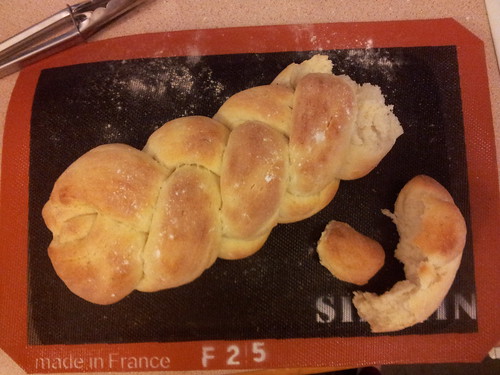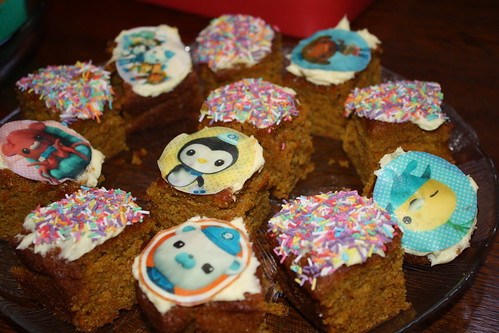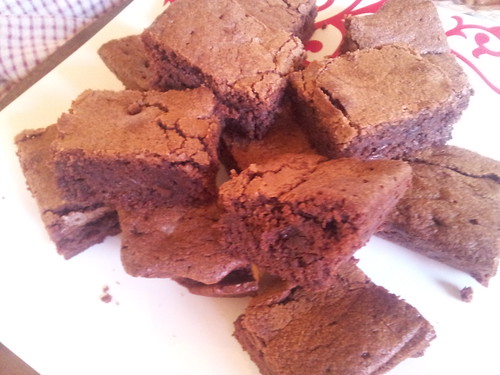At present, we are feeling rather swamped in our crop of home grown Dutch Cream potatoes. So far it is not even a particularly prolific crop (there are still four plants in the ground about which I’m feeling very nervous) but it has produced more potatoes than we can reasonably eat and we are not in possession of a root cellar. If we were, it would be a wine cellar.
Fortunately, I’ve made potato bread before and I thought it would be an opportunity to kill a couple of birds with one stone. The toddler refuses to eat both potatoes and bread (the exceptions being chips in a pub and one type of milk roll that my mum makes). I originally thought that growing and digging up potatoes might enthuse him but it turns out that it has only enthused him in shouting about the “tatoes in the garden” and ferreting about in the soil.
Making the bread dough (using a recipe from The Big Book of Bread) with him was surprisingly difficult. He was excellent at ricing the potatoes but four hands in a mixing bowl (yep, we did this all by hand … the KitchenAid got a break!) made for a lot of flour on the bench and made it very difficult for me to judge how much water we needed to add. And a toddler can shove a surprising amount of part made bread dough in his mouth when you’re not looking. Apparently raw flour, raw dough and everything in between are ripe for ‘tasting’.
It’s surprising then that doing the four plait with his help was actually really easy. While Peppa Pig is inculcating my child with all manner of feminist socialist politics, she’s also taught him all about creating ‘wiggly worms’ so I was able to give him chunks of dough and let him loose.
So – the four plait. We were originally going to make rolls, as I figured that small hands might be able to work with simple knots. However, I decided that I also need to stretch myself just a bit. I enjoyed watching almost all of Masterchef Professionals (UK), including the bread skills test where Monica Galetti set four chefs the task of, amongst others, doing a four plait.
I’ve never done this before but having had long hair almost my entire life I am totally adept at a three plait (in hair, but not shabby when it comes to bread either). So when I say that I found this easy to do – you’ve got your caveat.
I had a look around the internet for written (rather than video) instructions because the thing with plaiting is that you need to know which strand to put where. The instructions at Alchemy in the Kitchen were exactly what I needed.
With plaiting you number the positions of the strands (left to right or right to left doesn’t matter) and then you follow a sequence. You’ll find variations on this but I followed the above which is:
4 over 2
1 over 3
2 over 3
rinse and repeat
You need to make your strands of dough tapered at the ends so that you can tuck them under and make a tidy loaf (note – not what I did!). And you need to keep your plaiting tight so you do need to do a bit of fiddling as you work. The “2 over 3” step is particularly counter intuitive. What this is doing is creating a spine for the rest of the plait to sit on. Keep this in mind and work tight and you’ll be fine! Though perhaps not up to doing this in front of Monica Galetti …
However, your toddler might still refuse to eat bread and you’ll scoff the lot with plenty of butter in the space of a couple of days …
Ingredients
- ~ 350g potato, peeled, cubed, boiled, riced/mashed and cooled
- 500g flour
- 2 tsp (7g) dried yeast
- 2 tsp salt (don't skimp)
- 35g finely grated parmesan cheese (this doesn't need to be too precise, use more if using a not so strongly flavoured cheese)
- 1 1/2 tsp fennel seeds (or other herb/seed of your choice - carraway would work well too)
- freshly ground black pepper
- ~ 200mL warm water
Instructions
- Mix the flour and potato together in a large bowl. Use your hands and incorporate so that the mix is crumbly.
- Add the yeast, salt, cheese, seeds and pepper and mix well.
- Slowly add the warm water. You may need more or less than the 200mL depending on your flour, so add about half and incorporate well before adding a little more as you need it. You need to bring all the ingredients together in a soft dough.
- Tip the dough out onto a lightly floured bench and give it a good keading, until the dough is soft and silky. Lightly grease the dough and return to its bowl. Cover the bowl and leave to rise until roughly doubled in size.
- Lightly knead again and, if doing a four plait, divide the dough into four equal portions and form these into ropes that are slightly tapered at both ends.
- Plait using the 4 over 2, 1 over 3, 2 over 3 approach. Do the plait on a slightly floured baking tray (or use a siplain (silicone) mat, which you can move onto a baking tray easily later).
- If not plaiting, shape into whatever shape you want. Or even make rolls.
- Cover and leave to roughly double again.
- Preheat oven to 180C fan (200C conventional) and cook for approximately half an hour. Bread should be risen, tanned in colour and should sound hollow when tapped on the base. If making rolls, you'll probably need about 15-20 minutes in the oven.
- Leave to cool on a wire rack and gobble down with lashings of butter!




